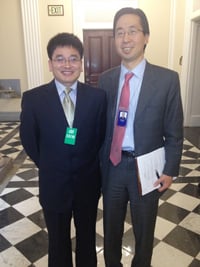- December 18, 2012
- FOXITBLOG
On December 4, 2012, the White House Business Council conducted a meeting at the White House in Washington, DC to obtain feedback from over 25 business leaders representing a variety of company sizes, industries, and geographies across the country. Foxit Corporation was invited to participate to represent a Californian technology company from Silicon Valley. George Gao, Senior Vice President of Sales and Marketing, represented Foxit at this meeting. The main purpose of this meeting was to obtain feedback from businesses regarding the upcoming “fiscal cliff” and other ways for government and businesses to work together in order to grow the economy and create jobs. In the United States, the fiscal cliff is a term used to refer to the economic effects that could result from tax increases, spending cuts, and a corresponding reduction in the US budget deficit beginning in 2013 if existing laws are not changed by the end of 2012.
The agenda for the meeting was the following:
- The President’s Agenda and Budget Framework
– Heather Higginbottom, Deputy Director, Office of Management and Budget, The White House
- Moving the Budget Agenda and Middle-Class Tax Cuts
– Greg Nelson, Chief of Staff, National Economic Council, The White House
– Ari Matusiak, Executive Director, White House Business Council
- Panel on Economic Competitiveness and Innovation
– Todd Park, Chief Technology Officer and Assistant to the President, The White House
– Jim Shelton, Assistant Deputy Secretary for Innovation and Improvement, U.S. Department of Education
– Jonathan McBride, Deputy Director for Presidential Personnel, The White House
– Sean Greene, Associate Administrator, Office of Investment and Innovation, U.S. Small Business Administration
Much of the fiscal cliff discussions focused on the impact to the middle class and small businesses. Business leaders understood that tax revenues need to increase but must be accompanied by decreases in government spending. The discussions became very lively at times, representing many different viewpoints. George emphasized that educational spending needs to be maintained and/or increased, not cut.
The business leaders stressed that the US Government can do more to spur technology innovation at the federal, state, and local levels. This discussion focused on education and technology, such as online technology courses, liberating data (putting information online that exist only on paper today), showcasing technology, and getting business involved in delivering technology sessions in partnership with the education system.
